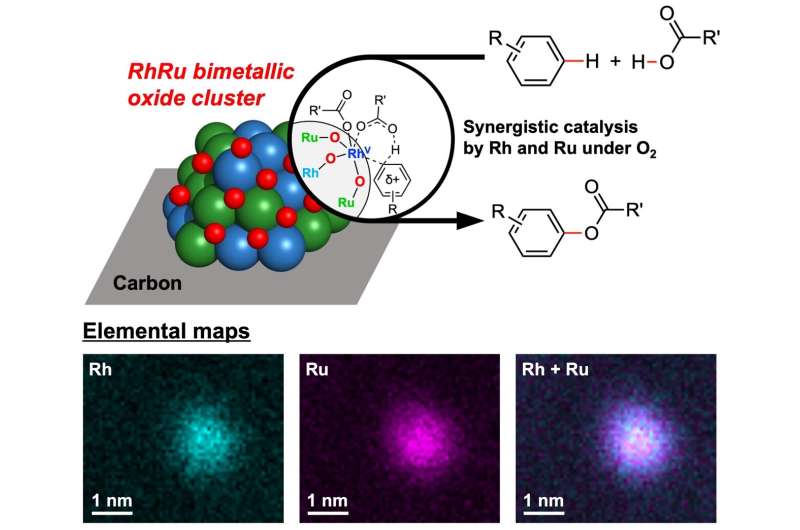This article has been reviewed according to Science X's editorial process and policies. Editors have highlighted the following attributes while ensuring the content's credibility:
fact-checked
peer-reviewed publication
trusted source
proofread
New catalysts enable greener ester synthesis

A new catalyst may well catalyze a shift to greener chemistry. Chemists from Yokohama National University have successfully developed innovative catalysts containing two noble metals that demonstrate remarkable efficiency in ester-producing chemical reactions and utilize oxygen as the sole oxidant, making the process much more environmentally friendly and sustainable.
Their results were published in the Journal of the American Chemical Society on June 6.
Cross-Dehydrogenative Coupling (CDC) reactions belong to the category of C−H bond activation reactions, which play a crucial role in organic synthesis and industrial chemistry. CDC reactions have been extensively developed as sustainable chemical synthesis strategies owing to their atom economy, meaning they use reactants efficiently and minimize waste.
CDC reactions between arenes and carboxylic acids activate the C–H bond of arenes (aromatic hydrocarbons such as benzene) to form C–O bonds with carboxylic acids to directly produce aryl esters. Esters are chemical compounds widely used in various industries, including pharmaceuticals and polymer production.
These CDC reactions, however, require oxidants, or oxidizing agents, to occur.
"Cross-dehydrogenative coupling reactions of arenes and carboxylic acids have typically been conducted by homogeneous catalysts with hazardous oxidants such as hypervalent iodine reagents," said Ken Motokura, a professor at the Faculty of Engineering of Yokohama National University and corresponding author of the study.
Traditional oxidants can be highly toxic to humans and animals, cause explosions, or produce pollution or harmful byproducts. These methods, therefore, pose significant environmental and safety concerns.
Seeking a greener approach, the research team developed catalysts called RhRu bimetallic oxide clusters (RhRuOx/C), which are composed of two metals from the noble metals group, Rhodium (Rh) and Ruthenium (Ru), combined with oxygen.
With a mean diameter of just 1.2 nm, these catalysts demonstrated exceptional catalytic activity in CDC reactions while utilizing oxygen as the sole oxidant. Molecular oxygen is non-toxic, abundant, environmentally benign and highly efficient in converting reactants to products, with water being the only byproduct.
Using advanced imaging and spectroscopic techniques, the researchers confirmed the structure and formation of the RhRu bimetallic oxide clusters. Detailed kinetic and computational studies revealed the reaction mechanism. The catalysts' high reactivity with various types of arenes and carboxylic acids was demonstrated, making them versatile for producing aryl esters.
"Our study shows that noble-metal-based bimetallic oxide clusters are promising for the C–H bond activation reactions using molecular oxygen as the sole oxidant," said Shingo Hasegawa, an assistant professor at the Faculty of Engineering of Yokohama National University and first author of the study.
The new catalysts show potential for making chemical reactions more sustainable and efficient, opening up possibilities for greener chemical synthesis. The researchers plan to explore the use of these catalysts in other important chemical reactions.
"Our ultimate goal is to establish efficient and regioselective C–H functionalization reactions catalyzed by metal oxide clusters using molecular oxygen under mild conditions, promoting more environmentally friendly chemistry practices," Motokura said.
More information: Shingo Hasegawa et al, RhRu Bimetallic Oxide Cluster Catalysts for Cross-Dehydrogenative Coupling of Arenes and Carboxylic Acids, Journal of the American Chemical Society (2024). DOI: 10.1021/jacs.4c03467
Journal information: Journal of the American Chemical Society
Provided by Yokohama National University



















